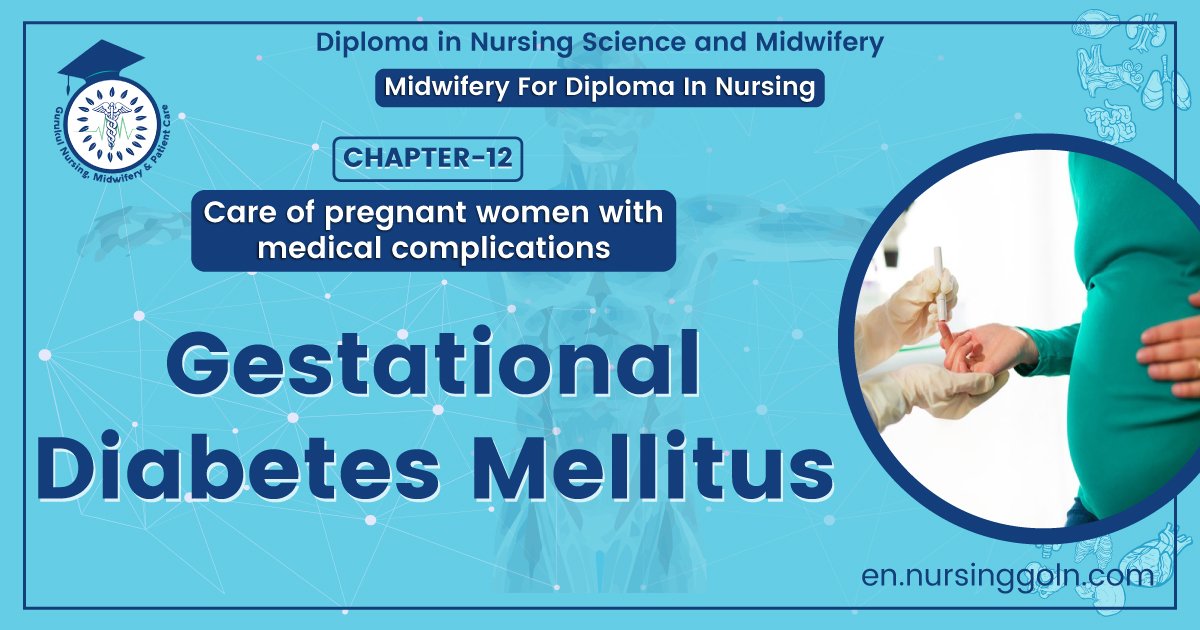Gestational Diabetes Mellitus – This course is designed to understand the care of pregnant women and newborn: antenatal, intra-natal and postnatal; breast feeding, family planning, newborn care and ethical issues, The aim of the course is to acquire knowledge and develop competencies regarding midwifery, complicated labour and newborn care including family planning.

Gestational Diabetes Mellitus
Gestational diabetes mellitus/DM in pregnancy
Gestational diabetes mellitus/GDM:
GDM can be defined as diabetes that appears in pregnancy for the first time in a previously non-
diabetic patient & disappears after delivery.
Changes in CHO metabolism in pregnancy:
Transfer of increase glucose from mother to fetus is needed throughout the pregnancy; so that the following changes may occur-
➤ Increase insulin secretion: Due to hyperplasia & hypertrophy of pancreatic B-cell.
➤ Decrease insulin sensitivity of insulin receptor.
➤ Abnormal OGTT.
➤ Overall effect on mother: Fasting hypoglycaemia, post-prandial hyperglycaemia.
A. During pregnancy:
➤ Spontaneous abortion with uncontrolled DM.
➤ Polyhydramnios (25-50%)-common.
➤ Pre-eclampsia (25%)
➤ Pre-term labour (20%).
➤ Recurrent infection (UTI).
➤ Maternal distress (mainly due to polyhydramnios).
B. Due to uncontrolled DM:
✔ Diabetic ketoacidosis.
✔ Diabetic retinopathy.
✔ Diabetic nephropathy.
C. During labour: Increased incidence of
➤ Prolongation of labour due to big baby.
➤ Shoulder dystocia.
➤ Perineal injury.
➤ Post-partum haemorrhage (PPH).
➤Increased operative interference.
D. During puerperium:
➤ Increased incidence of puerperal sepsis.
➤ Lactation failure.
E. Effects on the fetus:
➤Fetal macrosomia (30-40%); i.e. big baby (birth weight > 3.5 kg).
➤ Fetal congenital anomalies (6-10%): Neural tube defect, anencephaly, microcephaly, ASD
➤ VSD etc.
➤ Birth injury (due to big baby).
➤ Unexplained fetal death.
F. Neonatal complications:
➤ Hypoglycaemia
➤ Respiratory distress syndrome..
➤ Hyperbilirubinaemia.
➤ Polycythaemia.
➤ Hypocalcaemia.
➤ Hypomagnesaemia.
➤ Cardiomyopathy.
Causes of IUD in DM:
Exact cause of IUD in DM is unknown. It may be due to fetal metabolic disturbance which leads to-
➤ Severe fetal acidosis or
➤ Fetal blood hyper-viscosity.
Risk factors of gestational diabetic mellitus (GDM):
✔ increasing maternal agefamily
✔ history of type 2 diabetes or GDM
✔ certain ethnic groups
✔ previous unexplained stillbirth
✔ previous macrosomia
✔ obesity (three-fold risk of GDM)
✔ smoking (two-fold risk of GDM
✔ change in weight between pregnancies: an inter-pregnancy gain of more than three BMI points doubles the risk of GDM)

Effects of pregnancy on diabetes:
1. Insulin antagonism: By the hormones secreted by placenta; e.g. human placental lactogen, estrogen, progesterone & free cortisol Hyperglycaenia.
2. Insulin degradation: More insulin is degraded by placental insulinase enzyme- Decreased maternal insulin Hyperglycaemia.
3. Increased renal glycosuria: More glucose leaks out in the urine due to renal glycosuria so urine examination may give false result to control GDM & repeated blood glucose estimation is mandatory.
4. Ketoacidosis &hypoglycaemia: Hyperemesis gravidarum in early pregnancy Hypoglycaemia& Ketoacidosis Make insulin adjustment difficult due to variation in blood sugar level.
5. Vascular changes: Retinopathy, nephropathy, neuropathy & coronary artery disease may be worsen during pregnancy.
6. Inadequate nutrition & exertion of labour makes the blood sugar level unstable; so control of diabetes is difficult.
7. Women with gestational diabetes are at increased risk of developing diabetics later in life.
Management of DM or GDM in pregnancy:
Principles of management:
A. Careful antenatal supervision.
B. Control of diabetes mellitus.
C. Obstetric management.
D. Follow up.
A. Careful antenatal supervision:
➤ Antenatal supervision should be monthly upto 20 weeks & thereafter at 2 weeks interval.
➤ The diet pattern should be same as other diabetic patient.
➤ Frequent blood sugar (both fasting & 2 hours after breakfast) estimation is required.
➤ HbA1C level of 5-6% is desirable.
➤ Assessment of fetal wellbeing including anomaly: By ultrasonography.
B. Control of diabetes mellitus:
➤ Insulin should be used always.
➤ Oral hypoglycaemic agents are contraindicated.
C. Obstetric management:
➤ Women who has good blood sugar control and who don not require insulin therapy → wait for spontaneous delivery.
➤ The patients require insulin or having complications like macrosomia C/S is the treatment of choice.
D. Follow up:
➤ To see development of overtabetes.
➤ Nearly 50% of women with GDM will develop diabetes in course of 5-20 years.

Screening of GDM:
A. Low risk:
➤ Absence of any risk factors.
➤ Blood glucose testing is not routinely required.
B. Average risk:
➤ When some risk factors are present we should perform RBS. If RBS is suggestive then we should do OGTT.
C. High risk:
➤ We should screen as a routine all the risk factors are present at first RBS & if RBS is suggestive then we should do OGTT & treat accordingly.
Causes of glycosuria in pregnancy:
➤ Renal glycosuria.
➤ Impaired glucose tolerance (IGT) during pregnancy.
➤ Gestational diabetes mellitus (GDM) or diabetes mellitus.
➤ Lactosuria.
Read More.
